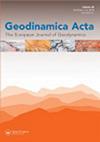mustafakemalpa断裂西段活动构造与古地震特征布尔萨,西北安纳托利亚
IF 1.5
Q1 Earth and Planetary Sciences
引用次数: 8
摘要
mustafakemalpaa断层(MF)位于Manyas、Ulubat和Orhaneli断层之间,是一条长度为47公里的右侧走滑断层。中风从西面的气压脊开始,并在东面显示复杂的缓动终止,以抑制左侧的气流。断裂西段与中新世和第四纪单元交界,向İlyasçılar方向延伸。断层的中心部分,开始于大约750米的向左陡坡,在Kapaklıoluk和Kabulbaba之间呈现正弦几何形状。在这一段,MF穿过山地地形,切割蛇绿岩、侏罗纪灰岩和中新世碎屑,形成右旋断裂特征,获得逆分量。东段为左台阶阶梯式,在奥尔哈内利河上偏移2.5 km。本文介绍了与全新世活动和活动构造性质有关的古地震学发现。这些海沟暴露了不匹配的地层,证明了断层上发生的事件。我们确定了过去4000年间发生的三个事件(公元前2190年之前,公元1425年之后和1850年之后)。根据Orhaneli河晚上新世流域的海沟资料和偏移量,我们认为MF具有较长的非特征重现间隔和~0.7 mm/y的滑移率。本文章由计算机程序翻译,如有差异,请以英文原文为准。
Active tectonic and palaeoseismological features of the western section of Mustafakemalpaşa Fault; Bursa, NW Anatolia
The Mustafakemalpaşa Fault (MF), located among Manyas, Ulubat and Orhaneli faults, is a right lateral strike-slip and 47 km in length. The MF begins with a pressure ridge at the west and exhibits complex jog terminations at east ends in restraining left stepovers. The western section of the fault bounds Miocene and Quaternary units and continues towards İlyasçılar. The central segment of the fault, starts with approximately 750-m leftward stepover, exhibits a sinusoidal geometry between Kapaklıoluk and Kabulbaba. In this section, MF traverses mountainous terrain and cuts Ophiolite, Jurassic limestones and Miocene detritals, forming dextral faulting features and gaining reverse component. The eastern section exhibits left stepping en-echelon pattern and consists 2.5-km offset on the Orhaneli River. In this study, palaeoseismological findings related to the Holocene activity and active tectonic properties of the MF are presented. The trenches exposed mismatched stratigraphy, demonstrating evidence of events across the fault. We identified three events (before BC 2190, later AD 1425 and 1850) that have occurred during the past 4000 years. We suggest a long non-characteristic recurrence interval and ~0.7 mm/y slip-rate for MF, based on trench data and offset of the Late Pliocene drainage of Orhaneli River.
求助全文
通过发布文献求助,成功后即可免费获取论文全文。
去求助
来源期刊

Geodinamica Acta
地学-地球科学综合
CiteScore
4.50
自引率
0.00%
发文量
0
审稿时长
25 weeks
期刊介绍:
Geodinamica Acta provides an international and interdisciplinary forum for the publication of results of recent research dealing with both internal and external geodynamics. Its aims to promote discussion between the various disciplines that work on the dynamics of the lithosphere and hydrosphere. There are no constraints over themes, provided the main thrust of the paper relates to Earth''s internal and external geodynamics. The Journal encourages the submission of papers in all fields of earth sciences, such as biostratigraphy, geochemistry, geochronology and thermochronology, geohazards and their societal impacts, geomorphology, geophysics, glaciology, igneous and metamorphic petrology, magmatism, marine geology, metamorphism, mineral-deposits and energy resources, mineralogy, orogeny, palaeoclimatology, palaeoecology, paleoceanograpgy, palaeontology, petroleum geology, sedimentology, seismology and earthquakes, stratigraphy, structural geology, surface processes, tectonics (neoteoctonic, plate tectonics, seismo-tectonics, Active tectonics) and volcanism.
Geodinamica Acta publishes high quality, peer-reviewed original and timely scientific papers, comprehensive review articles on hot topics of current interest, rapid communications relating to a significant advance in the earth sciences with broad interest, and discussions of papers that have already appeared in recent issues of the journal. Book reviews are also included. Submitted papers must have international appeal and regional implications; they should present work that would be of interest to many different specialists. Geographic coverage is global and work on any part of the world is considered. The Journal also publishes thematic sets of papers on topical aspects of earth sciences or special issues of selected papers from conferences.
 求助内容:
求助内容: 应助结果提醒方式:
应助结果提醒方式:


